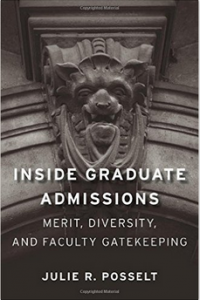 Last December I saw a fascinating talk by Julie Posselt.1 She described work deriving from her PhD dissertation in which she sat in on meetings of doctoral admissions committees in a variety of disciplines at several different (and anonymous) elite private and public research university. She described how overreliance on “cut points” for GPA, GRE scores, or both led to admissions decisions that favored applicants from relatively privileged backgrounds. Even though the faculty making those decisions were almost uniformly committed to ensuring that they admitted doctoral students from a wide variety of backgrounds, the pool of admitted students was far less diverse than the pool of applicants. As she put it in a piece for Inside Higher Ed earlier this year: “Despite their good intentions to increase diversity, broadly defined, admissions work was laced with conventions — often rooted in inherited or outdated assumptions — that made it especially hard for students from underrepresented backgrounds to gain access.”
Last December I saw a fascinating talk by Julie Posselt.1 She described work deriving from her PhD dissertation in which she sat in on meetings of doctoral admissions committees in a variety of disciplines at several different (and anonymous) elite private and public research university. She described how overreliance on “cut points” for GPA, GRE scores, or both led to admissions decisions that favored applicants from relatively privileged backgrounds. Even though the faculty making those decisions were almost uniformly committed to ensuring that they admitted doctoral students from a wide variety of backgrounds, the pool of admitted students was far less diverse than the pool of applicants. As she put it in a piece for Inside Higher Ed earlier this year: “Despite their good intentions to increase diversity, broadly defined, admissions work was laced with conventions — often rooted in inherited or outdated assumptions — that made it especially hard for students from underrepresented backgrounds to gain access.”
Why does this happen? Partly it’s because faculty aren’t aware of advice from the Educational Testing Service on how to use GRE scores properly.2 Partly, it’s because there are so many applicants to high-quality doctoral programs that admissions committees often use numerical screens to identify the small number of applicants worthy of close scrutiny.
Athene Donald points out another way in which relying on strict numerical criteria may be harmful to everyone, regardless of what their demographic, economic, social, or cultural background may be. She argues in the context of evaluating academics that in addition to the usual metrics of publication or creative activity and grant dollars (for those in fields where external funding is important), success as an academic should also include “building teams, seeing their students thrive and progress, working with people who sparked them off intellectually and seizing opportunities to try out new things and make new discoveries.”
The challenge, of course, is that you get what you measure. If we only measure publications and grants, that’s what we’ll get. If we want to encourage team building and student support, we have to measure those things and give them as much weight as the things we traditionally measure. If we can’t find numbers with which to measure them, we still need to find ways to assess them, because helping others gain the skills they need is what education is all about.
1The talk was given at the annual meetings of the Council of Graduate Schools.
2I’m no different from everyone else in this regard. I wasn’t even aware that ETS provided this kind of advice until I became a dean 4 1/2 years ago.
